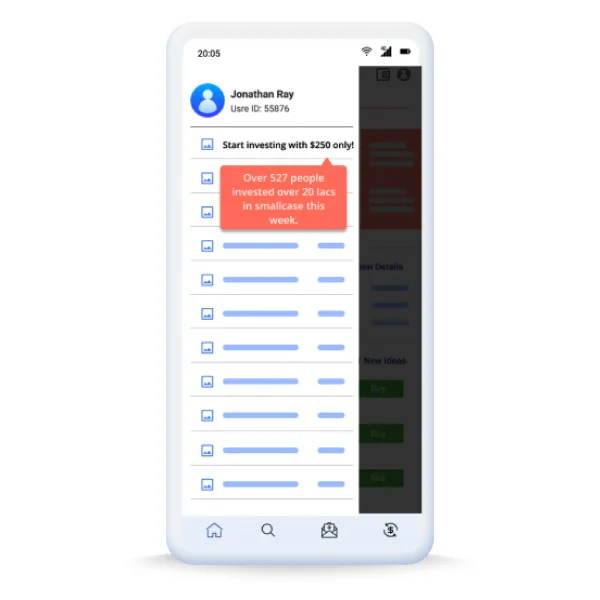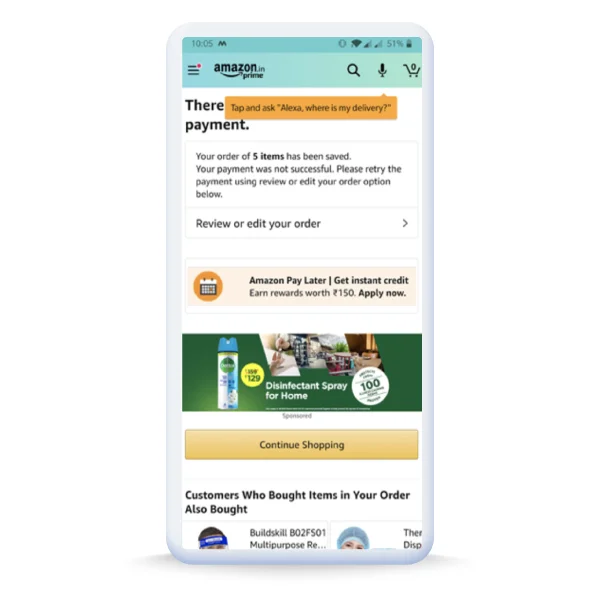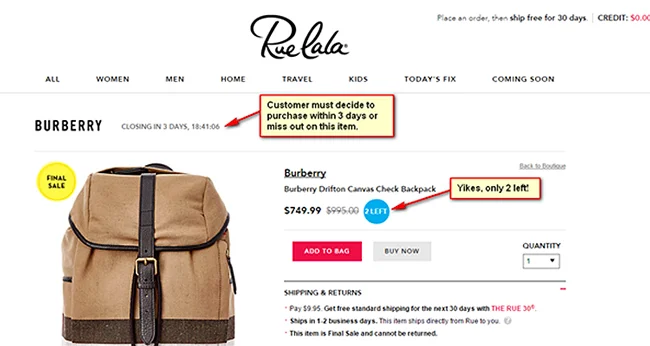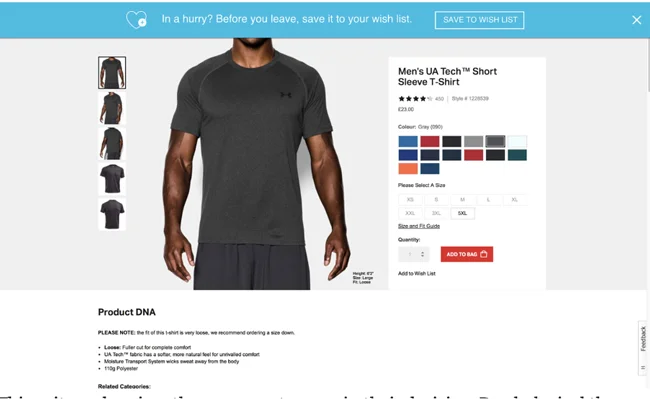Nudge marketing is becoming increasingly popular in the e-commerce space. We come across several nudge marketing examples on every landing page we visit these days. Strategically placed nudges grab customers’ attention without needing bold discounts and offers.
In the competitive e-commerce space, brands need a strategy that guides customers to make the right choice and quick buying decisions.
And this is where nudge marketing or contextual nudges come into the picture. From Amazon to IKEA, giant online retailers are making the best use of nudges to improve their customer engagement, conversion, and retention.
An introduction to nudge marketing
Nudge marketing is all about helping customers make better decisions without hesitation. Or it can be defined as a marketing practice used by brands to communicate brand messages that induce desired behavior by appealing to consumer psychology.
When customers visit your e-commerce site, they often struggle with too many options. By narrowing down choices and subtly guiding them, you can improve conversion and retention rates.
You might have noticed how some e-commerce stores label their products as “high in demand” or “popular choice”. That’s what you call a subtle nudge which is likely to influence their customers’ buying decision.
To know everything about nudges and how it evolved from the nudge theory, read The what, why and, how of nudges.
How do nudges work?
Nudges work by subtly influencing customers’ decisions without restricting their choices. They use psychological principles to guide customers to take actions like making a purchase or signing up for a newsletter. This approach respects consumer autonomy while still steering behavior in beneficial ways.
Types of nudges in marketing
E-commerce brands use various types of nudges in marketing to influence customer behavior:
- Setting Defaults: Pre-selects options for users, making it easier to choose, often presenting the best or recommended choice.

- Social Nudge: Leverages social proof by showing product popularity or usage, encouraging users to follow the crowd.

- Highlighting: Uses visual cues like size, color, or contrast to draw attention to specific options or offers.

- Warning: Alerts users to potential risks, helping them make informed decisions by highlighting critical information.

- Disclosure: Provides clear and accessible information, ensuring users are aware of important details before making decisions.

- Announcement: Informs users about new features or offers without disrupting their experience, focusing on timing and relevance.

- Reminders: Helps users remember important actions like payments or appointments, tailored to their behavior and needs.

- Surveys: Collects user feedback to understand preferences and reduce drop-offs, aiding in product improvement and customer satisfaction.

10 best nudge marketing examples for higher conversion and retention
Here are 10 best practical use cases and nudge examples in marketing that help in conversion and retention.
1. Smart product labeling by IKEA
IKEA has been quite creative in using smart product labels that trigger the psychology of its potential customers.

By labeling some products as ‘IKEA Family Price’, they are appealing to the psychology of deal-hungry family shoppers. By labeling a couple of products as new, they are trying to appeal to the psychology of customers who would like to buy novelty products.
Also, they have star-marked some products as highly rated products that will appeal to the customers for whom other customers’ rating matter. Customer rating is something that I also consider when buying a product. And I think this works for a lot of other customers too. So why not highlight the best-rated products?
2. Use popularity and scarcity like Booking.com
The popular hotel booking site booking.com has been successfully using nudge marketing tactics like social proof, popularity, and scarcity.

In this example, the site is subtly nudging customers by putting social proof and scarcity in the spotlight. Your customer’s buying decision involves a lot of small decisions. If you could appeal to their psychology by highlighting features that will help them seamlessly reach those small decisions, you are nudging them in the right direction and making their life easy.
3. Use scarcity to create FOMO like Amazon
Amazon is the king of nudges and one of the first brands that started using nudge marketing to influence their customer decision.

In this example, they have made the product really exclusive by highlighting scarcity. Also, how the potential customers can get the product delivered faster if they order in a particular time frame.
Another example is one where Amazon nudges its customers towards using Alexa more frequently. Along with boosting feature adoption it will also enhance customers’ shopping experience with Amazon, which, in turn, will boost retention.

4. Offer guest checkout like Mango
This one’s my favorite because it’s subtle and quite helpful. Mango’s e-commerce site makes sure that they don’t heckle the customer buying decision by making registration mandatory. And let’s accept it, we all love guest checkouts.
However, by replacing log-in with returning customers, they won my heart. This subtle nudge reinforces that their customers keep returning because of their brand value. Won’t that be fascinating for any frequent online buyer?
Also, they have replaced the sign-up or registration option with ‘are you new?’ and let customers continue shopping by just filling in their email address. Also, they have stated that customers can create an account later. Now that’s what I call the right kind of nudge marketing.

5. Creating urgency for limited stock items by Rue La La
Flash sale sites like Rue La La effectively appeal to customers who don’t want to miss out on big discounts on brands like Burberry. They use scarcity to encourage swift decision-making.
Rue La La creates a sense of urgency by informing customers about the limited stock and time period to buy an item. The blue-highlighted stock indicator subtly nudges customers to act quickly before the item sells out.

6. Exit intent overlay for customer retention
A lot of e-commerce brands are already using the ‘Add to Wishlist’ feature under each product, but most customers fail to even notice this amazing feature.

You can always reintroduce this as an overlay nudge with autonomy when the user is about to exit the site. If your customer adds that item to his or her wish list, you can always retarget them with a remarketing campaign. The best part is they are making the nudge skippable, so no regrets whatsoever.
7. Time sensitive product drop like Ntwrk
Ntwrk is using the scarcity of products by pushing their time-sensitive product drop notifications. I found this one pretty smart.

In this example, they are driving the early promotion of the new products that are yet to arrive. The countdown on the banner image is trying to convey that the new product line is likely to get out of stock when it arrives because the demand for new collections is usually high.
8. Highlight the popularity of product with social proof
You can always spotlight the popularity of products with social proofs like ‘how many people viewed this product’, ‘this item is trending’, and ‘customer reviews’. Believe it or not, it creates wonders.

A social proof example that uses the wisdom of the crowd
Yes! Your customer needs that one last push. If you reinforce in their mind that the product they are looking for is well in demand by highlighting the social proofs. It will nudge them in the right direction and help them make a faster buying decision.

9. Highlighting functional benefits like OYSHO and ASOS
Oysho is a women’s home wear and activewear website. The website design is minimalistut they drive the user behavior by highlighting the functional benefits of each item.

Another great example of highlighting functional benefits is by ASOS. They have added labels that help customers look for jeans correlating to their body shape. And I think it makes for quite an apt nudge marketing example that helps boost the customer retention rate.

10. Nudge customers to increase the cart value
I personally never like to pay the shipping charges. I am certain a lot of others love free shipping too. So, e-commerce sites can always appeal to the psychology of customers who are reluctant to pay the shipping charges. You can do this by nudging them to add another valuable item to their cart to enjoy free shipping.

Must Read – Must have contextual nudges & walkthroughs: Ft. E-commerce apps
Why use nudge marketing?
Nudge marketing is a powerful tool that enables brands to subtly influence consumer behavior without being intrusive. By leveraging psychological principles, it guides customers towards beneficial actions, such as making a purchase, signing up for a service, or engaging with content.
Here are key reasons why brands should consider using nudge marketing:
1. Increased Engagement: Nudge marketing can capture and maintain customer attention by presenting timely and relevant prompts. For instance, highlighting popular products or offering personalized recommendations can encourage customers to explore more of what a brand offers.
2. Higher Conversion Rates: By making the decision-making process simpler and more intuitive, nudges can help reduce friction in the customer journey. This can lead to higher conversion rates as customers find it easier to complete desired actions, such as adding items to a cart or completing a purchase.
3. Improved Customer Retention: Nudges can enhance the overall customer experience by providing helpful information and suggestions. For example, reminding customers of items left in their cart or offering exclusive deals based on past purchases can encourage repeat business and foster loyalty.
4. Cost-Effective Marketing: Compared to more traditional, aggressive marketing tactics, nudge marketing is cost-effective. It often requires minimal investment to implement simple nudges that can have a significant impact on customer behavior.
5. Enhanced User Experience: Nudges can improve the user experience by making it more personalized and relevant. By understanding customer preferences and behavior, brands can tailor their messaging and interactions, creating a more seamless and enjoyable shopping experience.
6. Ethical and Respectful: Unlike hard-sell tactics, nudge marketing respects consumer autonomy. It gently steers customers towards beneficial choices without limiting their options or overwhelming them with aggressive marketing. This ethical approach can enhance a brand’s reputation and foster trust with consumers.
7. Behavioral Insights: Implementing nudges can provide valuable insights into consumer behavior. By analyzing how customers respond to different nudges, brands can better understand their audience and refine their marketing strategies accordingly.
8. Adaptability Across Platforms: Nudge marketing is versatile and can be applied across various digital platforms, from e-commerce websites to mobile apps and email marketing. This adaptability allows brands to reach customers wherever they are, providing consistent and effective nudges.
Overall, nudge marketing offers a strategic advantage for brands looking to enhance engagement, increase conversions, and build lasting customer relationships. By integrating subtle cues into the customer journey, brands can effectively guide consumers towards positive actions while maintaining a respectful and user-friendly approach.
When should you use nudges in marketing?
Nudges should be used when you want to:
- Simplify the decision-making process for customers.
- Highlight key product features or benefits.
- Encourage desirable behaviors, such as purchasing or signing up for newsletters.
- Reduce cart abandonment by offering incentives like free shipping.
How do nudges help with higher retention in e-commerce?
Nudges help with higher retention by creating a more engaging and personalized shopping experience. They can highlight the benefits of products, make the checkout process easier, and offer incentives that encourage repeat purchases. By making the shopping experience more enjoyable and seamless, nudges can increase customer loyalty and retention.
Why choose Netcore for nudges?
Netcore’s Product Experience Platform offers a comprehensive solution for implementing nudge marketing strategies. With features like:
- No-Code Contextual Nudges and Walkthroughs: Easily deploy nudges without requiring engineering efforts.
- Customizable Nudge Library: Choose from a variety of nudge types and customize them to fit your brand’s needs.
- Robust Segmentation Engine: Build personalized experiences for different customer segments.
- Agility in Building Experiences: Empower your product teams to create and deploy new experiences quickly.
Nudge marketing, if implemented strategically, can be a powerful tool for e-commerce brands looking to enhance customer engagement and retention. By understanding and leveraging consumer psychology, brands can guide customers toward desired actions in a subtle and non-intrusive manner. Whether through highlighting popular products, creating a sense of urgency, or simplifying the checkout process, nudges can significantly impact customer behavior and business success.
Ready to craft great app user experiences for your e-commerce brand? Talk to us, and know more about Netcore’s ecommerce marketing platform.








